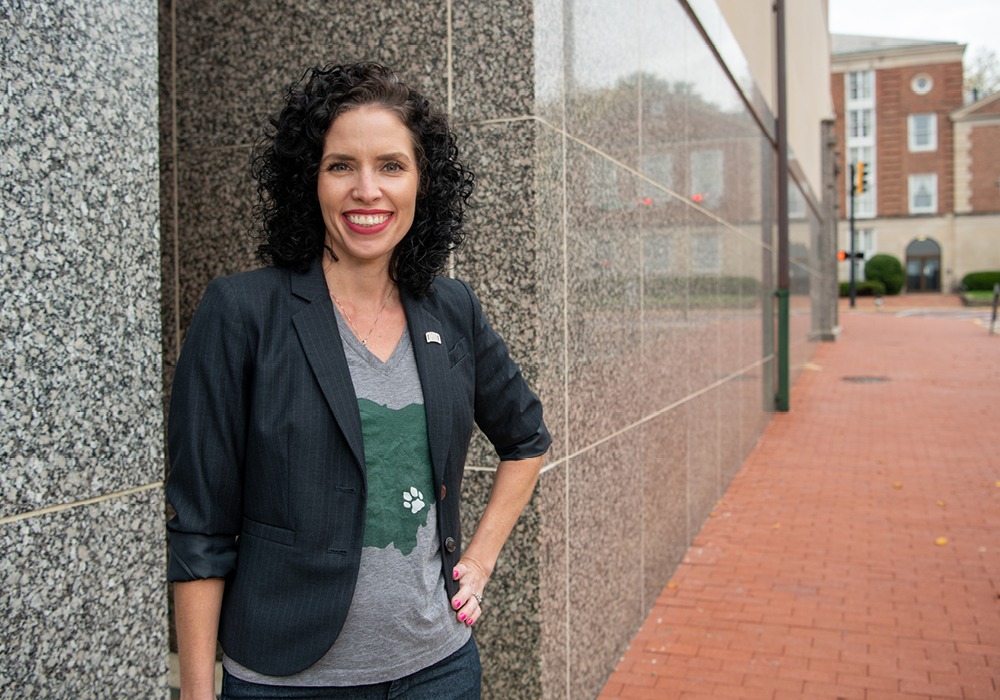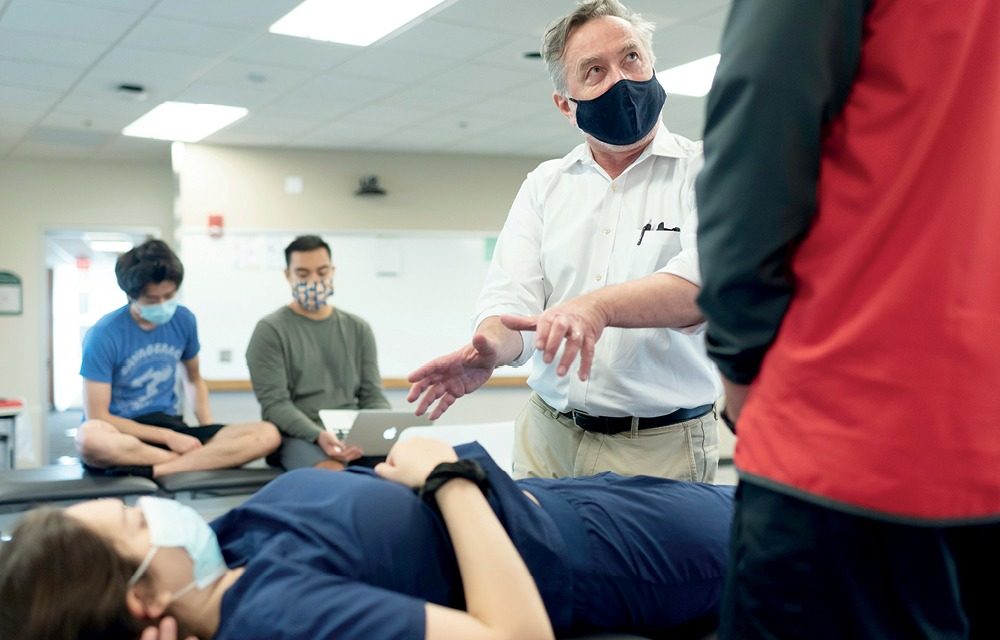
Changing course — and courses
It’s the thirteenth week of fall semester, and Shawnee Meek logs on to a video meeting with a group of students in her Strategic Business Communication course. The group is checking in to get feedback on a presentation due in a few days. The presentation will, of course, be virtual. This is 2020 after all.
Mary Reed, BSJ ’90, MA ’93 | April 1, 2021
Share:
Meek, an assistant professor of instruction in Ohio University’s College of Business, offers constructive feedback on the group’s presentation deck. “Use the slide to answer the question instead of asking the questions,” she suggests.
The course hones students’ professional skills in writing, interpersonal communications and formal presentations. And now, by default, the course teaches how to do it all in a virtual setting.
The shift from in-person to remote learning happened abruptly over a two-week period in March 2020, when the coronavirus pandemic sent students home after spring break and required faculty to finish teaching their courses remotely. As in, more than 7,500 sections of 3,300 unique courses across all of OHIO’s campuses.
OHIO mobilized a highly coordinated and comprehensive approach—involving the Office of Information Technology, the Office of Instructional Innovation and University Libraries—to provide resources, including checklists, consultations and IT support, to help faculty make the transition. The Office of Instructional Innovation offered remote teaching workshops like “Tips for Teaching Large Enrollment Classes Online” and “Tips for Teaching Labs Online.” From March through December, hundreds of faculty members participated in those workshops.
Meek enrolled in a two-part course on remote teaching fundamentals, where she learned technological and organizational tips, plus how to make her classes inclusive and sensitive to students’ needs. She often begins class with a quick check-in, asking students to drop notes into the chat function about how they’re doing.
“I try to bring that encouragement and positivity to the students,” Meek says. “It can be a dark time for the whole world right now, so I try to be a light for them.”

Shawnee Meek, an assistant professor of instruction in Ohio University’s College of Business, was one of hundreds of OHIO faculty members who participated in workshops designed to help transition courses to an online format. Photo by Ben Wirtz Siegel, BSVC ’02
Leo Foulds is a senior accounting and business analytics major. He opted to take satisfactory/no credit grades for spring 2020—an option Ohio University offered to soften the blow of a sudden shift from in-person to remote learning. After going home to New Hampshire for the summer, Foulds returned to Athens for fall semester to continue his virtual learning.
Like his professors, he had to adopt a digital smorgasbord of technology: Zoom, Microsoft Teams, Blackboard, VoiceThread, MindTap, Proctortrack. University usage of Microsoft Teams alone illustrates how massive the shift was: In April 2019, an average of 12 meetings were held via Teams per day. In April 2020, that number skyrocketed to nearly 2,000 while private chats exceeded 35,000.
Foulds says that overall he has learned as much information as he would in a regular classroom. There have even been a few benefits, like a flipped classroom model for an accounting course, where he watched recorded lectures prior to class and then he and his classmates used the class meeting time to work on accounting problems together while getting immediate feedback from the professor.
As a digital native, the technological transition was quite easy for Foulds. The challenge? “Learning how to manage more free time and flexibility and staying motivated.” But having a lot more free time than usual has had an upside—Foulds has been getting some of the best grades of his college career.
The challenge for other students is the digital divide. Some students simply don’t have the hardware or the broadband to study from home. Since spring 2020, OHIO’s Office of Information Technology has loaned some 250 laptops and 40 mobile hotspots to students who don’t have high-speed internet.
Hands on, masks up
Not all teaching and learning can be done remotely. Medical students at the Ohio University Heritage College of Osteopathic Medicine learn clinical skills through hands-on learning activities and in-person labs, where they work with simulated patients in simulated clinic settings. They begin by taking an actor-patient’s medical history, using stethoscopes to conduct heart and lung exams, and engaging with the patient and staff to make diagnoses and suggest treatments.

Stevan Walkowski, DO ’89, chair of and associate professor in the Department of Osteopathic Manipulative Medicine, instructs students during a lab at the Heritage College, Dublin. Photo by Srijita Chattopadhyay, MA ’21
So, when the pandemic hit, the Heritage College quickly adjusted clinical skills and osteopathic manipulative medicine labs to allow for the safe continuation of these integral hands-on medical education activities. That meant moving exam tables to create at least six feet between them, setting limits on the number of people who could safely be together within a space and implementing many other safety and hygiene measures. Faculty and students who would have previously intermingled now would be assigned to small learning pods where they would work only with and on each other. And, of course, everyone would wear a mask at all times.
Stevan Walkowski, DO ’89, chair of and associate professor in the Department of Osteopathic Manipulative Medicine, acknowledges that initial apprehension from students and faculty quickly faded as the new protocols proved successful, both in terms of safety and learning outcomes. He credits his colleagues at the Heritage College for pulling it off.
“They really rose to the occasion in terms of trying to brainstorm how to make (it) work,” he says. “That really speaks to the commitment they have to the students and to the education.”
Kaitlyn Blacha, a second-year medical student at the Heritage College, Dublin, experienced the shift from “normal” clinical skills labs to the new—and, hopefully, temporary—normal. “You can’t ask (the patient) to pull down their mask to ask them to ‘Say ahh,’” Blacha notes.
In addition, medical students are graded on empathy. “It’s hard to show empathy when you can’t get close to the patient,” she adds. “You can’t show your face; you can’t hand them a Kleenex.”
As for Walkowski, he looks forward to when he, his students and his colleagues can return to unmasked, undistanced medical education. “Human contact is extremely important.”



